
- Usage in publication:
-
- Grape Creek bed
- Modifications:
-
- Original reference
- Dominant lithology:
-
- Limestone
- Clay
- AAPG geologic province:
-
- Bend arch
- Llano uplift
Summary:
Pg. 412, 427. Grape Creek bed in Albany division. Mostly light-gray or dove-colored, rather friable fossiliferous limestone, with more or less clay in southern and northern parts of field. Thickness 100 to 150 feet. Member of Albany division [Albany is uppermost of 5 Carboniferous divisions of Cummins, 1891]. Underlies Talpa bed and overlies Bed No. 12 (12 to 75 feet of clay). Age is possibly Permian.
[Named from Grape Creek, Coleman Co., Colorado River region, central TX.]
Source: Publication; US geologic names lexicon (USGS Bull. 896, p. 857).
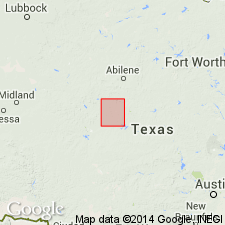
- Usage in publication:
-
- Grape Creek formation
- Modifications:
-
- Revised
- AAPG geologic province:
-
- Bend arch
- Permian basin
Summary:
Grape Creek formation, 130 feet thick, underlies Talpa formation and overlies Bead Mountain formation [in which bed No. 12 seems to be included]. Grape Creek formation is distinguished from Bead Mountain beds by paucity of worm and SYRINGOPORA remains, the introduction of Mollusca and Molluscoidea, and, most noticeably, by nature of bedding of rocks. [Age is Permian.]
Source: US geologic names lexicon (USGS Bull. 896, p. 857).
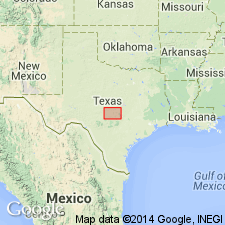
- Usage in publication:
-
- Grape Creek shale and limestone bed
- Modifications:
-
- Revised
- AAPG geologic province:
-
- Bend arch
Summary:
Pg. 197, 198. Grape Creek shale and limestone bed is basal member of Clyde formation (of Wichita group). Underlies Talpa limestone and overlies Bead Mountain limestone, top member of Belle Plains formation. [Age is Permian.]
Source: US geologic names lexicon (USGS Bull. 896, p. 857).
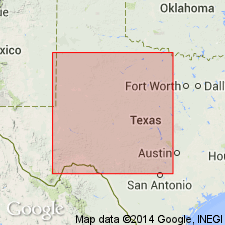
- Usage in publication:
-
- Grape Creek formation
- Modifications:
-
- Revised
- AAPG geologic province:
-
- Bend arch
Summary:
Pg. 66 (fig. 1). Grape Creek formation of Clyde group. Given formational status in the Clyde herein given group status. [Age is Permian.]
Source: US geologic names lexicon (USGS Bull. 1200, p. 1576).
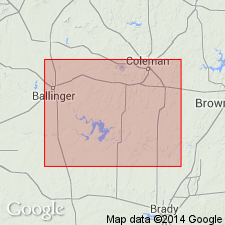
- Usage in publication:
-
- Grape Creek limestone member*
- Modifications:
-
- Revised
- Mapped
- AAPG geologic province:
-
- Bend arch
Summary:
Sheet 2. Grape Creek limestone member of Clyde formation. In Colorado River Valley, member constitutes lower three-fifths of formation. Consists of thin beds of uniform blue-gray limestone. Thickness uniformly about 325 feet. Underlies Talpa limestone member; overlies Bead Mountain limestone member of Belle Plains formation. Division of Clyde into members in this area is not as natural as in the area north of Abilene; in this mapped area they might appropriately be treated as formations. Fossiliferous (DICTYOCLOSTUS, PINNA, BELLEROPHON). Age is Early Permian (Leonard?).
Source: Publication; US geologic names lexicon (USGS Bull. 1200, p. 1576).
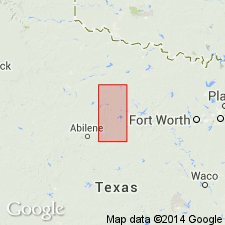
- Usage in publication:
-
- Grape Creek limestone member*
- Modifications:
-
- Areal extent
- AAPG geologic province:
-
- Bend arch
Summary:
Pg. 275. Grape Creek limestone member of Clyde formation. In Brazos River Valley, is 20 to 45 feet thick, and consists of upper and lower limestone beds separated by shale. Limestone beds range from 2 to 8 feet in thickness, and shale from 15 to 40 feet. Overlies unnamed shale at base of formation; separated from overlying Talpa limestone member by unnamed shale member. [Age is Permian.]
Source: Publication; US geologic names lexicon (USGS Bull. 1200, p. 1576).
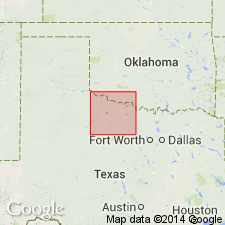
- Usage in publication:
-
- Grape Creek Formation
- Modifications:
-
- Mapped
- AAPG geologic province:
-
- Bend arch
Summary:
Grape Creek Formation of Albany Group. Shale and limestone, 100 to 120 feet thick. Underlies Talpa Formation and overlies Bead Mountain Formation, both of Albany. Equivalent to middle part of Waggoner Ranch Formation (new) of Wichita Group. Earlier workers included these rocks in Clyde Formation. Fossils. Age is Early Permian (Leonard).
Geographic extent arbitrarily placed along North Fork of Little Wichita River; [notable exposures south of Wichita River, in Baylor and Throckmorton Cos.]
Source: Publication.
For more information, please contact Nancy Stamm, Geologic Names Committee Secretary.
Asterisk (*) indicates published by U.S. Geological Survey authors.
"No current usage" (†) implies that a name has been abandoned or has fallen into disuse. Former usage and, if known, replacement name given in parentheses ( ).
Slash (/) indicates name conflicts with nomenclatural guidelines (CSN, 1933; ACSN, 1961, 1970; NACSN, 1983, 2005, 2021). May be explained within brackets ([ ]).

